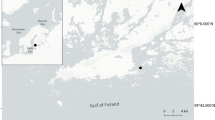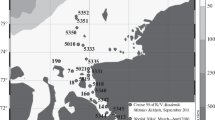Abstract
During austral summer 1988/89, total bacterial Acridine Orange Direct Counts (AODC) in seawater, mean 6.0×106 l−1, were three to ten times lower than generally reported for the Bransfield Strait to north Weddell Sea area. In contrast, numbers of viable bacteria (Colony Forming Units, CFU), mean 10.6×103 l−1 were two to three times higher than reported. Bacterial abundance here shows large seasonal and spatial changes. On the basis of bacterial, diatom, detritus, and amino acid data from this study, two main regions were defined: ‘Cold winter water’ in the west with high salinity and low CFU, AODC, and other parameters. In the east, lower salinity and higher values for all parameters were found in warmer meltwater at the surface. CFU and AODC values in ice were respectively six and 85 times higher than in surrounding seawater. Taxonomic studies indicate considerable diversity in genera and nutritional requirements of isolated bacteria. Sea-ice and water column bacterial communities differed. Many isolated strains, however, were found in both habitats. Sea-ice seems to be important in regulating surrounding bacterioplankton.
Similar content being viewed by others
References
Bio Merieux (1990) API 20NE. Analytical Profile Index, #2 009 0. 4th edition. Bio Merieux SA, 69280 Marcy-l'Etoile, France, pp 1–278
Bölter M, Dawson R (1982) Heterotrophic utilisation of biochemical compounds in Antarctic waters. Neth J Sea Res 16:315–332
Bölter M (1987) Microbiological, Planktonic and chemical characteristics and their validity for separation of water masses in the Bransfield Strait, Antarctica. S Afr J Mar Sci 5:133–143
Buchanan RE, Gibbons NE (1974) (eds) Bergeys Manual of Determinative Bacteriology (8th Ed.). Williams and Wilkins, Baltimore, Md, pp 1246
Cassel EA (1965) Rapid Graphical Method for Estimating the Precision of Direct Microscopic Counting Data. Appl Microbiol 13:293–296
Chróst RJ (1990) Microbial ectoenzymes in aquatic environments. In: Overbeck J, Chróst RJ (eds) Aquatic Microbial Ecology: Biochemical and Molecular Approaches, Springer, New York, pp 47–78
Chróst RJ (1991) Environmental control of the synthesis and activity of aquatic microbial ectoenzymes. In: Chróst RJ (ed) Microbial enzymes in aquatic environments. Springer, New York, pp 29–59
Dawson R, Liebezeit G (1980) Dissolved free amino acids. In: Grasshoff K (ed) Methods of seawater analysis. Verlag Chemie, Weinheim, 3–25
Delille D, Brandini F, Kivi K, Kuosa H, Norrman B (1989) Microbial Communities. In: Hempel I (ed) Reports on Polar Research 62–'89. The expedition Antarktis VII/1 and 2 (EPOS I) of r/v Polarstern in 1988/1989. Alfred-Wegener-Institut für Polar und Meeresforschung, D-2850 Bremerhaven, Germany pp 113–116
Doake CSM (1987) Antarctic ice and rocks. In: Walton DWH (ed), ‘Antarctic Science’, Camb Univ Press pp 140–192
Figueiras FG, Ferez F (1990) Hidrografia al borde del hielo entre las Islas Elefante y Las Orcada del Sur durante el verano austral 1988–89. In: Castellvi J (ed) Actas del tercer symposium Espańol de estudios Antarticos. Comision interministerial de ciencia y technologia, Madrid, Spain, pp 9–23
Griffiths RP, Caldwell BA, Morita RY (1982) Seasonal Changes in Microbial Heterotrophic Activity in Subarctic Marine Waters as Related to Phytoplankton Primary Productivity. Mar Biol 71:121–127
Halemejko GZ, Chróst RJ (1986) Enzymatic hydrolysis of proteinaceous particulate and dissolved material in an eutrophic lake. Archiv fur Hydrobiologie 107:1–21
Handa N, Tominaga H (1969) A detailed analysis of carbohydrates in marine particulate matter. Mar Biol 2:228–235
Hanson RB, Shafer D, Ryan T, Pope DH, Lowery HK (1983a) Bacterioplankton in Antarctic Ocean waters during late Austral winter: Abundance, Frequency of dividing cells, and estimates of production. Appl Environ Microbiol 45:(5) 1622–1632
Hanson RB, Lowery HK, Shafer D, Sorocco R, Pope DH (1983b) Microbes in Antarctic waters of the Drake Passage: Vertical patterns of substrate uptake, productivity, and biomass in January, 1980. Polar Biol 2:179–188
Hobbie JE, Daley RJ, Jasper S (1977) Use of Nuclepore filters for counting bacteria by fluorescence microscopy. Appl Environ Microbiol 33:1225–1228
Horner RA, Syversten EE, Thomas DP, Lange C (1988) Proposed terminology and reporting units for sea-ice algal assemblages. Polar Biol 8:249–253
Hoshiai T (1985) Autumnal proliferation of ice-algae in Antarctic sea-ice. In: Siegfried WR, Condy PR, Laws RM (eds) Antarctic Nutrient Cycles and Food Webs. Springer, Berlin Heidelberg New York, pp 89–92
Humble MW, King A, Phillips I (1977) API Zym: a simple rapid system for the detection of bacterial enzymes. J Clin Path 30:275–277
Inoue K (1977) Effect of temperature on growth of obligately psychrophilic bacteria. J Gen Appl Microbiol 23:53–63
Kim SJ (1991) Bacterial number, heterotrophy and extracellular enzyme activity in the Bransfield Strait, Antarctica. Kieler Meeresforsch, Sonderh 8:205–212
Kottmeier ST, McGrath Grossi S, Sullivan CW (1987) Sea ice microbial communities. VIII. Bacterial production in annual sea ice of McMurdo Sound, Antarctica. Mar Ecol Prog Ser 35:175–186
Kottmeier ST, Sullivan CW (1987) Late winter primary production in sea ice and sea water west of the Antarctic Peninsula. Mar Ecol Prog Ser 36:287–298
Kottmeier ST, Sullivan CW (1988) Sea ice microbial communities (SIMCO). 9. Effects of temperature and salinity on rates of metabolism and growth of autotrophs and heterotrophs Polar Biol 8:293–304
Kottmeier ST, Sullivan CW (1990) Bacterial biomass and production in pack ice of Antarctic marginal ice edge zones. Deep Sea Res 37:(8) 1311–1330
Larsson A-M, Nothig E-M, Dieckmann G, Ljungek G, Meyer K, Sehlstedt P-I (1989) The Under-Ice Water Layer. In: Hempel I (ed) Reports on Polar Research 62–'89. The expedition Antarktis VII/1 and 2 (EPOS I) of r/v Polarstern in 1988/1989. AlfredWegener-Institut für Polar und Meeresforschung, D-2850 Bremerhaven, Germany, pp 103–106
Ligowski R, Lipski M, Zielinski K (1988) Algae of drifting sea-ice north of Elephant Island (BIOMASS III. October 1986). Polish Pol Res 9:217–229
Mullins BW, Priddle J (1987) Relationships between bacteria and phytoplankton in the Bransfield Strait and southern Drake Passage. Br Antarct Surv Bull 76:51–64
Newell RC, Lucas MI, Linley EAS (1981) Rate of degradation and efficiency of conversion of phytoplankton debris by marine microorganisms. Mar Ecol Prog Ser 6:123–136
Payne JW (1980) Microorganisms and Nitrogen sources. John Wiley and Sons, New York, pp 1–764
Prego RR, Fraga F (1988) A colorimetric method for the determination of organic carbon in seawater. Inv Pesq 52:(3) 421–435
Priest FG (1984) Extracellular Enzymes. Van Nostrand Reinhold (UK) Co Ltd, Wokingham, pp 1–79
Riebesell U, Pamatmat M, Schiel S, Schloss I, (1989) Ecological aspects of aggregates. In: Hempel I, Schalk PH, Smetacek V (eds) Reports on polar research 65–'89. The expedition Antarktis VII/3 EPOS (leg 2) of r/v Polarstern in 1988/89. Alfred-WegenerInstitut für Polar und Meeresforschung, D-2850 Bremerhaven, FDR, pp 93–99
Sieburth JMcN (1979) Sea Microbes. Oxford Univ Press New York, pp 1–491
Smith WO, Nelson DM (1985) Phytoplankton biomass near a receding ice edge in the Ross sea. In: Siegfried WR, Condy PR, Laws RM (eds) Antarctic Nutrient Cycles and Food Webs. Springer, Berlin Heidelberg New York, pp 70–77
Stretch JJ, Hamner PP, Hamner WM, Michel CW, Cook J, Sullivan CW (1988) Foraging behavior of antarctic krill Euphausia superba on sea ice microalgae. Mar Ecol Prog Ser 44:131–139
Sullivan CW, Palmisano AC (1984) Sea Ice Microbial Communities: Distribution, Abundance, and Diversity of Ice Bacteria in McMurdo Sound, Antarctica, in 1980. Appl Environ Microbiol 47, 4:788–795
Sullivan CW, Palmisano AC, Kottmeier S, McGrath Grossi S, Moe R (1985) The influence of light on growth and development of the sea-ice microbial community of McMurdo Sound. In: Siegfried WR, Condy PR, Laws RM (eds) Antarctic Nutrient Cycles and Food Webs. Springer, Berlin Heidelberg New York, pp 78–83
Tearle PV, Richard KJ (1987) Ecophysiological grouping of Antarctic environmental bacteria by API 20NE and fatty acid fingerprints. J Appl Bact 63:497–503
Tokarczyk R, Lipski M. Perez FF, Prego RR (1991) Hydrology and hydrochemistry of the surface water layer near the sea-ice edge in the Scotia sea (Dec. 1988–Jan. 1989). Pol Polar Res 12:495–505
Vosjan JH, Olanczuk-Neyman KM (1991) Influence of temperature on respiratory ETS-activity of micro-organisms from Admiralty Bay, King George Island, Antarctica. Neth J Sea Res. 28(3):221–225
Williams PJ LeB, Berman T, Holm-Hansen O (1976) Amino acid uptake and respiration by marine heterotrophs. Mar Biol 35(1):41–47
Zdanowski MK (1982) Distribution of saprophytic bacteria in the southern Drake Passage and in the Bransfield Strait (February–March 1981, BIOMASS-FIBEX). Polish Pol Res 3:183–191
Zdanowski MK (1985) Distribution of bacteria, organic carbon and amino acids in the southern part of Drake Passage and in Bransfield Strait during the BIOMASS-SIBEX (December 1983–January 1984). Polish Pol Res 6:43–63
Zdanowski MK (1988a) Bacteria in pack-ice north of Elephant Island (BIOMASS III, October 1986). Polish Pol Res 9:203–216
Zdanowski MK (1988b) Matter conversion in the course of Krill (Euphausia superba Dana) decomposition in the Antarctic ecosystem. Part I. Pol Arch Hydrobiol 35:(1) 65–96
Zimmerman R (1977) Estimation of bacterial numbers; A new method for fluorescent staining of bacterial populations on membrane filters. Kiel Meeresforsch 30:24–27
Author information
Authors and Affiliations
Rights and permissions
About this article
Cite this article
Zdanowski, M.K., Donachie, S.P. Bacteria in the sea-ice zone between Elephant Island and the South Orkneys during the Polish sea-ice zone expedition, (December 1988 to January 1989). Polar Biol 13, 245–254 (1993). https://doi.org/10.1007/BF00238760
Received:
Accepted:
Issue Date:
DOI: https://doi.org/10.1007/BF00238760




